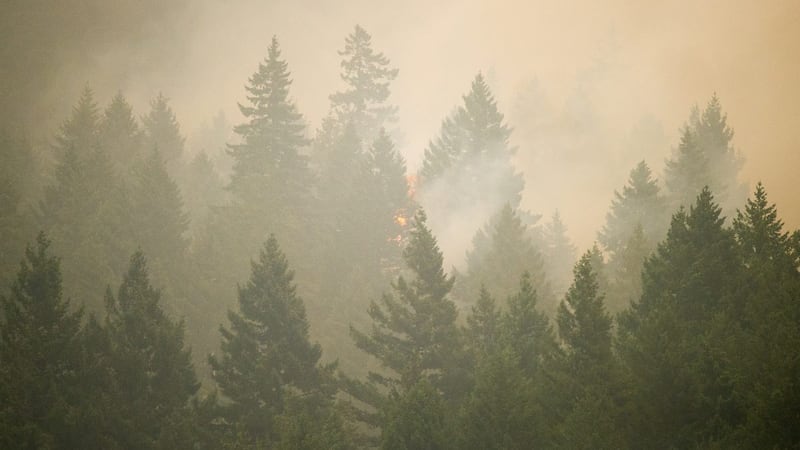In a 2012 YouTube video, seven hikers from Long Beach, Calif., launch themselves from 80 feet above the bottle-green waters of Punch Bowl Falls on the Eagle Creek Trail.
"Holy shit," says one, before taking the plunge. "I'm nervous."
She should have been. A year later, four young men from Cincinnati tried the same jump—three were injured and one died. In August 2016, a 20-year-old New Yorker fell from the falls and died as well.
At least eight other YouTube videos advertise the lure—and the danger—of the Eagle Creek Trail, "the most popular trail in the Columbia Gorge," in the words of the U.S. Forest Service.
Many Oregonians, including people who have hiked Columbia River Gorge trails for decades as part of their livelihoods, are grieving 10 days after a teenager, allegedly lobbing firecrackers into a trail-side ravine, started a wildfire that has now consumed 35,000 acres of forest.
"What surprised me the most is the visceral reaction people have had to the fire," says Kevin Gorman, executive director of the nonprofit Friends of the Columbia Gorge. "For so many people, it seemed like the death of a loved one."

In the days after the Sept. 2 fire raced from ridge to ridge, enormous public outrage has focused on a 15-year-old Vancouver boy who allegedly threw fireworks suspected of starting the fire—including demands for the juvenile's name and a torrent of online death threats. But Gorman and other experts say the damage is less the result of exceptional teenage idiocy than increasingly heavy use.
"The infrastructure was just not made for this many people," says Paul Gerald, author of 60 Hikes Within 60 Miles: Portland and other Oregon outdoor guidebooks.
Nobody knows exactly how many visitors use the Gorge trails. Rachel Pawlitz, a spokeswoman for the U.S. Forest Service, which oversees the Columbia River Gorge National Scenic Area, says that's because Gorge parking lots aren't gated like national parks, so it's hard to get a count.
Related: Roughly 3,000 scorched trees have been cleared from highway shoulders in the gorge.
One telling measure is the number of hikers who need rescuing from their encounters with nature.
The Hood River County sheriff's search and rescue team, which responded to the injured cliff jumpers and recovered the two bodies, has recorded a sharp increase in serious incidents on the Eagle Creek Trail—from 11 incidents in 2014 to 17 last year, a 55 percent increase.
The Multnomah County Search and Rescue team, which covers the Gorge from just east of Eagle Creek to the Gorge's end in Troutdale, has seen a similar increase, from 40 missions in 2014 to 63 last year, an increase of 58 percent.
Steve Kruger, a former Oregon State Parks ranger who worked in the Gorge from 2014 to 2016, says visitors who do foolish things in the area are nothing new—there are just more of them now.
"There've always been challenges with vandalism," says Kruger, now executive director of Trailkeepers of Oregon. "My biggest concern is the congestion and how that congestion causes a decrease in the quality of visitors' experiences."

Gorman and others point to several reasons: a booming population in the region, a strong economy, glowing national media coverage, and marketing efforts that lure tourists from all over.
"I think it was a steady, incremental growth for several years," Gorman says, "but in the past two years, it just sort of popped."
Gorman says he thinks YouTube, Facebook and Snapchat have played a role as well. "I have an 18-year-old daughter really interested in hiking," he says. "I think it's more social media than my influence."
The national scenic area covers 292,500 acres spread along 80 miles of the river. Friends of the Columbia Gorge describes 92 hikes on its website, and there are many more than that. But hikers ignore most of them, flocking in large numbers to the same few trails—Eagle Creek, Angel's Rest and Dog Mountain—over and over.
Gorman, who joined Friends of the Gorge in 1998 and has seen the nonprofit grow into an organization with 17 employees and $18 million in assets, says growth has brought more inexperienced hikers to the Gorge.
The avid outdoorsman climbed Dog Mountain earlier this year, once during the week and once on a weekend, and says he noticed a big difference in who was on the trail.

During the week, he says, hikers wore boots, sun protection and carried backpacks laden with water and the "10 essentials," including maps, sun block, extra clothing and first aid supplies.
On the weekend, it was a different story. "I spoke with a group that looked like they were going to a tailgate," Gorman says. "They were wearing cotton tank tops and sandals. They hadn't hiked much before, and they didn't know how far it was to the top."
Government agencies and nonprofits are working to address congestion in the Gorge. There are now shuttle services to address traffic and discussions of building a 200-mile trail network that would link towns and cities to attractions such as waterfalls and lakes so visitors don't overwhelm existing trailheads.
Some would like to make the historic Columbia River Highway one-way and do the same with popular trails.
Gorman says the Gorge, created 15,000 years ago by the massive Missoula floods and burned regularly by forest fires ever since, is resilient.
"I think the message that Eagle Creek is gone forever and the Gorge will never be the same is wrong," he says. "This is a place that for thousands of years has dealt with change. What we've seen is a tragedy, but we'll come out of this stronger."
